Types of House Beetles: Pictures, Identification and Control

House beetles are more than annoying bugs scurrying around your house. Beetles in the house can be destructive pests that contaminate food, destroy upholstery and carpets, and become a real nuisance. Knowing how to identify house beetles is key to getting rid of them for good.
Beetles get into your house in soil, groceries, used furniture, or even fly in through open windows. Therefore, identifying the beetle’s habits and habitat can help prevent a beetle infestation in your home.
This article is an identification guide to recognizing types of tiny beetles and flying beetles in your home. You will also get excellent tips on how to get rid of house beetles if they are in your pantry, carpets, furniture, or linen.
What are the Most Common House Beetles?
Carpet beetles, furniture beetles, and powderpost beetles are the most common beetles in the house. The tiny six-legged insects typically have a recognizable oval body. You can find them in cotton and natural fabrics, burrowing into wooden furniture, or living in dried foodstuffs.
What Are the Most Common Small Flying Beetles in the House?
Some beetle species have wings, and they can fly around your home. For example, warehouse beetles and drugstore beetles are two common flying beetles. Although rarer in homes, flying click beetles can sometimes find their way into your kitchen, living room, or bedroom through open doors or windows.
Types of House Beetles
House Beetles cause a lot of damage to homes. If you know how to identify them, you will know how to control them. It’s also vital to learn what attracts the pesky bugs.
Carpet Beetles (Anthrenus)
Carpet beetles are small spherical insects that look like brown or mottled brown lady beetles. The tiny beetles are typically 0.2” (5 mm) long and have a rounded body, six legs, and two antennae. There are three common types of carpet beetles in the home—the varied carpet beetle, furniture carpet beetle, and black carpet beetle.
Carpet beetles are also a type of small flying beetle. The annoying, destructive pests fly into homes.
Here are identifying features of carpet beetles in the house:
Varied carpet beetle (Anthrenus verbasci): Oval body with mottled black, brown, and yellowish patterns measuring 0.1” (0.25 mm).
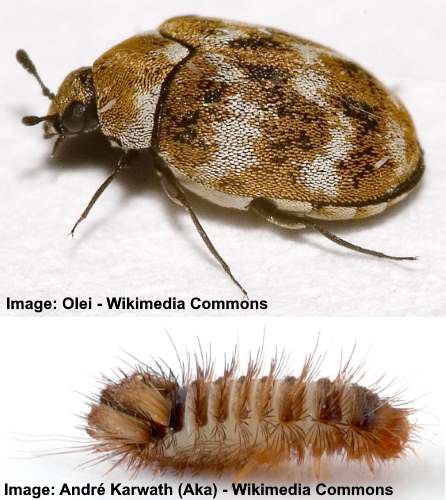
Varied carpet beetle (top image) and larva (bottom image)
Furniture carpet beetle (Anthrenus flavipes): Rounded body with dark yellow to orange patterns and black and white dots on its wing covers. Measures 0.06” to 0.12” (1.5 – 3 mm).
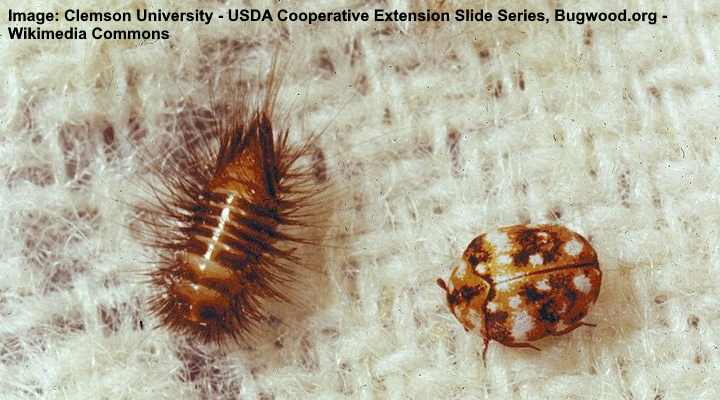
Anthrenus flavipes larva (left) and adult (right)
Black carpet beetle (Attagenus unicolor): Small black beetle with a shiny body and dark brown legs. Measures 0.12” to 0.18” (3 – 4.7 mm).
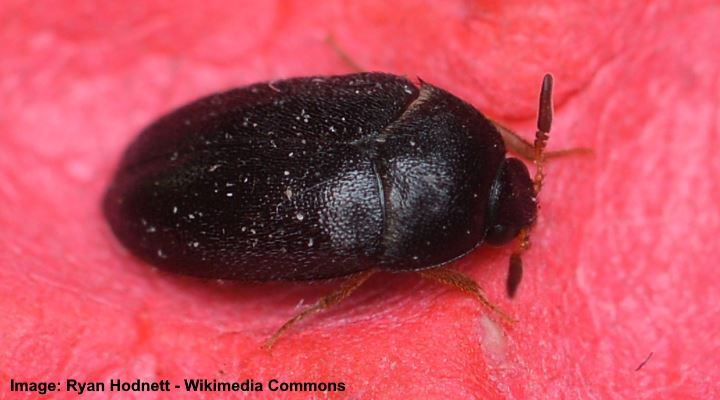
The black carpet beetle is a tiny bug that infests carpets and fabrics in the house
Typically, a few carpet beetles in the house are nothing to worry about. However, damage to carpets and upholstery occurs when they lay eggs and larvae hatch. The minuscule, tiny white and brown worms can do tremendous damage by chewing on fabric.
Signs of carpet beetles are shed skin, droppings that look like pepper, and a musty smell.
House Beetle Identification
Carpet beetles are identified as tiny rounded flying insects with oval bodies.
How to Get Rid of The House Beetles
The best method to get rid of carpet beetles is by using sticky traps. These can help to identify the source of the beetles.
To kill carpet beetles, you can wash infected fabrics at hot temperatures or dry clean them. Using hot steam to clean carpets and upholstery will also kill carpet beetles in all stages—egg, larva, and adult.
Common Furniture Beetle (Anobium punctatum)
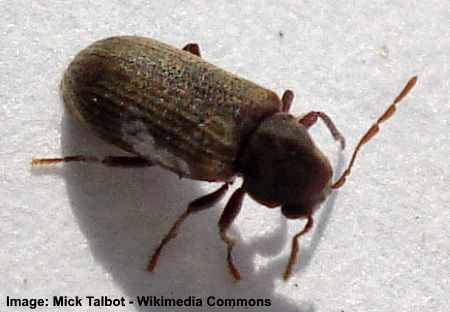
The furniture house beetles are small dark brown insects and their larvae cause damage to timber and to household furniture
The common furniture beetle is an insect with a dark brown elongated body and ribbed and pitted appearance. The small brown beetle has six legs and two segmented antennae. Furniture beetles measure 0.11” to 0.18” (2.7 – 4.5 mm).
Furniture beetle larvae damage wood by boring into timber. The tiny white larvae measure 0.39” (1 mm) and make tiny holes in wood that look like woodworm.
House Beetle Identification
The common furniture beetle is identified by its oval shape and dark brown, almost black color.
How to Get Rid of The House Beetles
The best way to get rid of and prevent furniture beetles is to reduce humidity indoors. However, it’s tricky to kill burrowing larvae that are in wood.
Powderpost Beetles
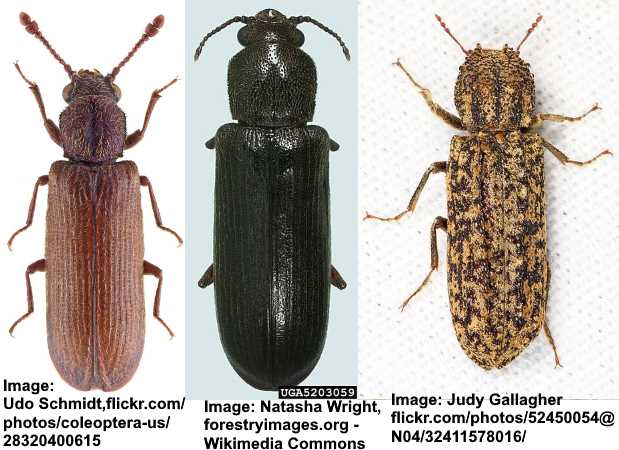
Powderpost beetles can vary in color, depending on the species. From left to right: European lyctus beetle (Lyctus linearis), southern lyctus beetle (Lyctus planicollis) and horned powderpost beetle (Lichenophanes bicornis)
The powderpost beetle is a common small house beetle. The small reddish-brown or brownish-black beetles tunnel into wood, weakening structures and creating tiny holes. The small, destructive pests measure 0.12” to 0.25” (3 – 6 mm) long. The small shiny brown beetles have a slender oval body and rounded thorax.
Like most beetle damage in homes, the grub-like larvae cause the most damage. The white bugs tunnel through wood, causing it to become a flour-like powder. Signs of powderpost beetle damage are a powdery, sawdust substance beside the wood and tiny holes in wood.
House Beetle Identification
Powderpost beetles are identified by their dark brown body, which is an elongated oval shape.
How to Get Rid of The House Beetles
The best way to prevent powderpost beetles from doing damage is to treat wooden items to stop the bugs from burrowing into the timber. In addition, it’s necessary to reduce humidity to a minimum.
Larder Beetle (Dermestes lardarius)
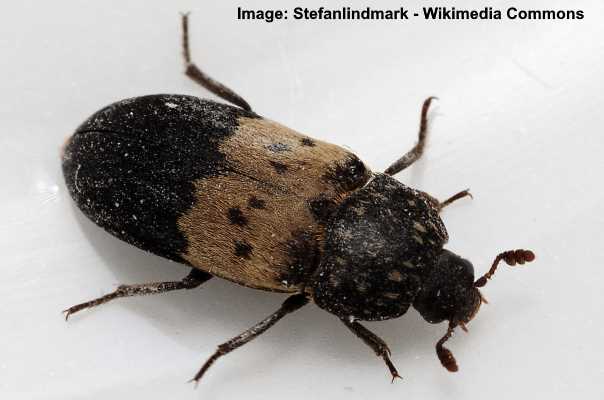
The small brown and black larder beetle is a domestic beetle pest that feeds on dried foodstuff
Larder beetles are black or dark brown, oval-shaped insects. The tiny beetles are a brownish to black color with a tan or yellowish band across the wing covers. There are also dark spots on the light-colored band. Larder beetles measure 0.33” to 0.37” (8 – 9.5 mm).
Larder beetles infest processed food in your pantry. They search out foods like cured meat, cheese, and pet food stored in dark places like kitchen cabinets. The dark-colored beetles may also feed on furs, feathers, insects, and dead animals.
House Beetle Identification
Larder beetles are identified as black and brown beetles with a recognizable beige-yellowish band across their backs.
How to Get Rid of The House Beetles
The best way to eliminate larder beetles is to store food in air-tight containers. Also, freezing food for a week can kill off these annoying house beetles.
Flour Beetles
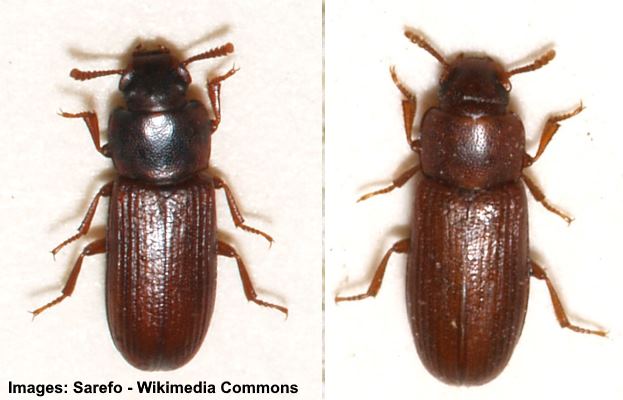
Flour beetles (Tribolium confusum on the left and Tribolium castaneum on the right) are small brown pantry bugs in the house, commonly found in flour and in the kitchen cabinets
Flour beetles are common pantry bugs with a reddish-brown flattened, oval body, two short, clubbed antennae, and six legs. The rusty-brown beetles typically measure 0.12” to 0.18” (3 – 5 mm) long. The two main types of flour beetle—Tribolium castaneum and Tribolium confusum—look virtually identical.
Flour beetles get into homes in dried grain products, especially flour. Signs of flour beetles are small white worms in grains, flour, pasta, dried legumes, and nuts.
House Beetle Identification
Flour beetles are easily recognized by their elongated rusty-brown bodies and short, stumpy segmented clubbed antennae.
How to Get Rid of The House Beetles
The best way to eradicate flour beetles is to seal infested produce in a plastic bag and put it in the outside trash can. Then, it’s vital to thoroughly clean all the cabinets where you suspect flour beetles were lurking.
Plaster Beetle (Cartodere constricta)
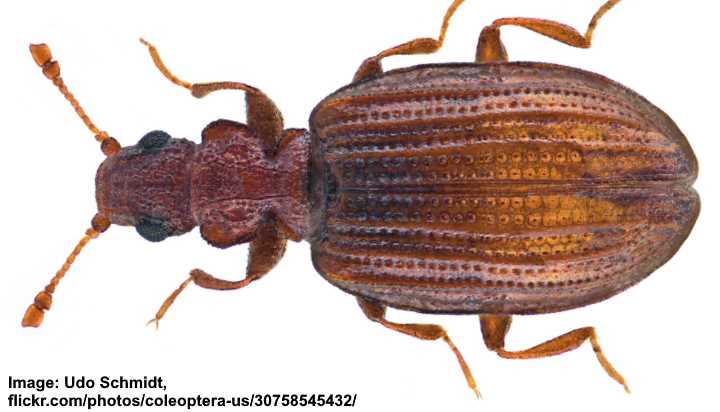
The tiny plaster beetle can be found in the house in humid environments
Plaster beetles are tiny six-legged insects with a light brown, oval body and small head and thorax. In addition, the minute brown scavenger beetle has an identifiable grooved back with rows of pits. Other identifying features are its segmented, clubbed antennae and its six legs, two of which are attached to the thorax.
Plaster beetles thrive in humid environments and feed on mold and mildew. Unfortunately, this characteristic means that the tiny brown beetles can contaminate food by spreading mold spores—a reason they are also called fungus beetles.
House Beetle Identification
Plaster beetles typically have an elongated body in various shades of brown with pits and grooves along their back. They measure between 0.05” and 0.08” (1.2 – 2 mm) long.
How to Get Rid of The House Beetles
To stop plaster beetles from infesting your house, reducing humidity and keeping stacked timber away from the home’s perimeter are crucial.
Grain Beetles
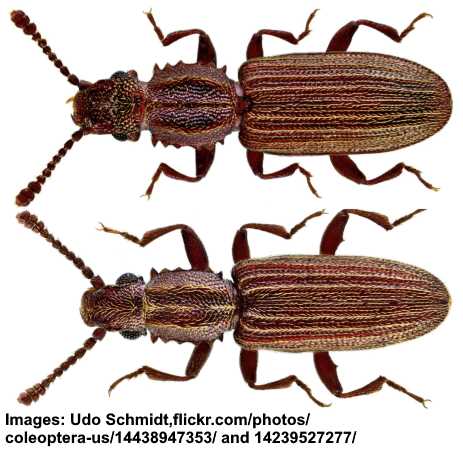
A close up image of grain beetles: Oryzaephilus surinamensis (top) and Oryzaephilus mercator (bottom)
Grain beetles are tiny brown insects with a brown or dark red color, elongated oval, flattened body, prominent eyes, and two segmented antennae. An identifiable feature of grain beetles is the six pointed projections on either side of the thorax. Brown grain beetles also have yellowish hairs on their wing covers.
The small brown beetles measure between 0.07” to 0.11” (2 – 3 mm).
The two most common grain beetles are the merchant grain beetle (Oryzaephilus mercator) and the sawtoothed grain beetle (Oryzaephilus surinamensis). However, there are several differences between the two types of beetles. For example, the merchant grain beetle flies, whereas the sawtooth grain beetle is a non-flying insect.
House Beetle Identification
Grain beetles are easy to recognize under a microscope by noting the pointed projections on the thorax, their pale brown to dark brown color, and rows of fine yellowish hairs.
How to Get Rid of The House Beetles
Grain beetle eradication is similar to killing all types of panty bugs. First, it is essential to trash any infected foods. These are typically cereals, pasta, chocolate, nuts, and cake mixes. Then disinfect areas where you noticed grain beetle activity.
Spider Beetle
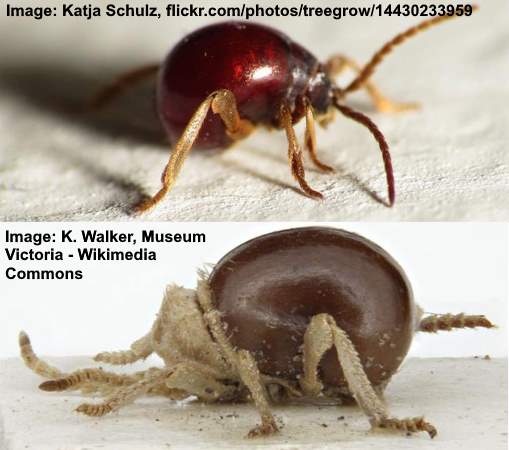
Close up pictures of spider beetles: Top: Smooth spider beetle (Gibbium equinoctial). Bottom: American spider beetle (Mezium Americanum)
Spider beetles are an unusual type of small brown beetle due to their shiny reddish brown or chocolatey-brown, bulbous body. In addition, the tiny beetles typically have furry legs, antennae, and heads. The annoying pantry bugs tend to inhabit damp, moist areas and are most active at night, making them difficult to spot.
Spider beetles typically measure 0.04” to 0.19” (1 – 5 mm). They can infest all sorts of dried foodstuffs like cereals, barley, wheat, spices, seeds, and dried fruits. Getting rid of the pesky bugs is vital because they also feed on dead insects and droppings.
House Beetle Identification
Spider beetles are easy to identify due to their humped appearance and shiny, reddish-brown color.
How to Get Rid of The House Beetles
The best way to rid your pantry of these house beetles is to remove their food sources. After discarding infested food, you should vacuum kitchen cabinets and disinfect all surfaces.
Granary Weevils (Sitophilus granarius)
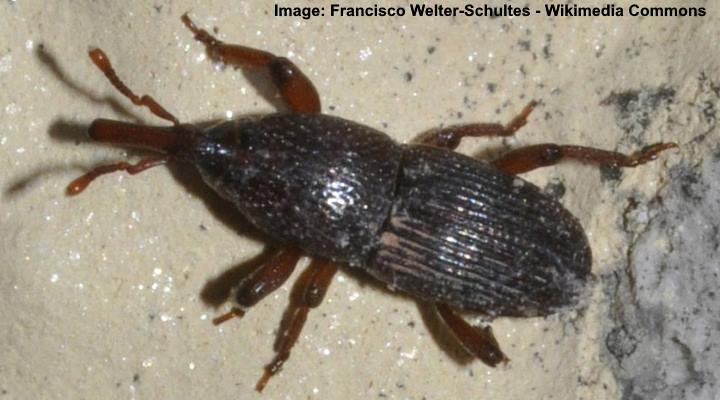
The little granary weevils are common in houses and are identified by their brown body with ridges and a long snout
Granary weevils are a common type of house beetle that infests kitchen pantries. The flightless dark brown beetle measures 0.12” to 0.25” (3 – 6 mm) long. The identifying feature of granary weevils is their long black snout—a characteristic of all weevils. However, the tiny beetles can also be black.
As their name suggests, granary weevils are found in dried foodstuffs. The reddish-brown or black beetle can live in packets of cereals, oats, rice, flour, and wheat. Because the beetles are so tiny, the most common sign of them is webbing dangling on the inside of packaging.
Granary weevils are also called wheat weevils or grain weevils.
Rice weevils (Sitophilus oryzae) and maize weevils (Sitophilus zeamais) are very similar in appearance to granary weevils. One of the differences is that rice weevils are smaller, and their reddish-brown bodies have orange markings. On the other hand, maize weevils are larger than grain or rice weevils.
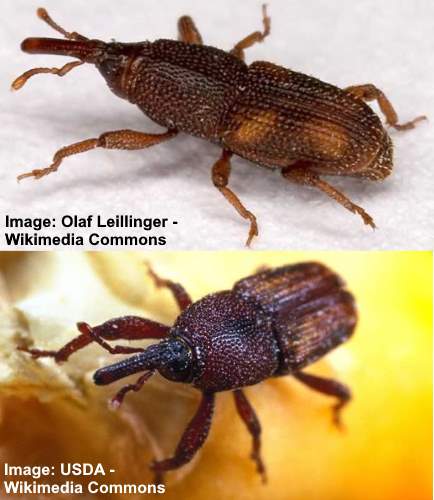
Close up images of rice weevil (top) and maize weevil (bottom)
House Beetle Identification
Granary weevils are identified by their dark reddish-brown or black color, elongated oval body, and long snout.
How to Get Rid of The House Beetles
Eradicating granary, rice, and maize weevils is the same for any type of pantry bug. First, it’s essential to store dried cereals, grains, and legumes in air-tight, sealable containers. Then, destroy or discard any infected products. And lastly, vacuum the inside of cabinets before disinfecting all surfaces.
Small Flying House Beetles
House beetles can also be a pest when they fly into homes. Here are descriptions and pictures of common flying house beetles.
Warehouse Beetles (Trogoderma variabile)
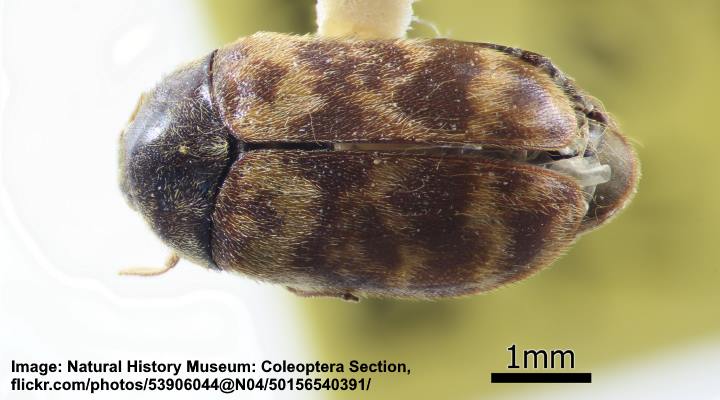
The warehouse beetle is a small pantry pest with light and dark brown patches on its oval body
The warehouse beetle is a type of carpet beetle that can fly. The small brownish beetle has a body in the shape of a coffee bean. The dark brown, reddish-brown, or blackish-brown pest grows about 0.13” (3.2 mm) long.
The destructive larva of the small flying beetle looks like a fuzzy grain of rice.
Warehouse beetles are also serious pantry bugs. The larvae feed on all kinds of dried foods, including seeds, corn, flour, oatmeal, spices, peas, grains, and fishmeal.
House Beetle Identification
The warehouse beetle is a dark brown, oval-shaped beetle with a mottled pattern on its wing covers.
How to Get Rid of The House Beetles
Like most pantry beetles, eliminating warehouse beetles starts with discarding any infested food items. Then it’s crucial to sanitize and wipe down all surfaces in your kitchen and clean the inside of cabinets.
Drugstore Beetle (Stegobium paniceum)
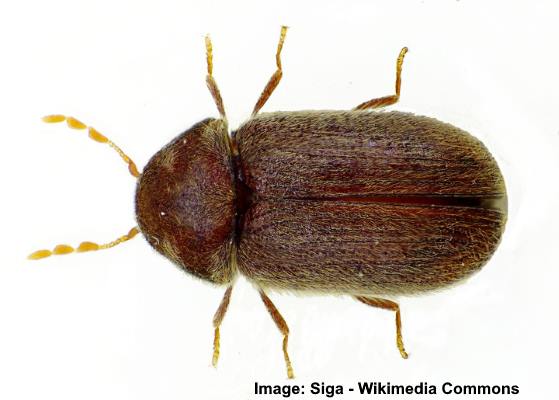
The tiny brown drugstore beetle has a hard shell and is commonly found in packets of dried food products in the kitchen
The drugstore beetle is a tiny brown oval beetle that can fly. Pictures of the tiny house beetle show a fuzzy reddish-brown body with grooved and pitted wing covers. Additionally, the small bug has yellowish segmented antennae. Drugstore beetles measure 0.08” to 0.13” (2.25 – 3.5 mm).
Drugstore beetles are commonly found near prescription drugs. However, the miniature flying house beetles also contaminate dried foodstuffs, making them pesky pantry bugs. You may find the tiny white worm-like grubs in dried beans, cereals, teas, and pet food.
Drugstore beetles look like another common flying pantry bug—cigarette beetles (Lasioderma serricorne). The most recognizable difference is the shape of their antennae.
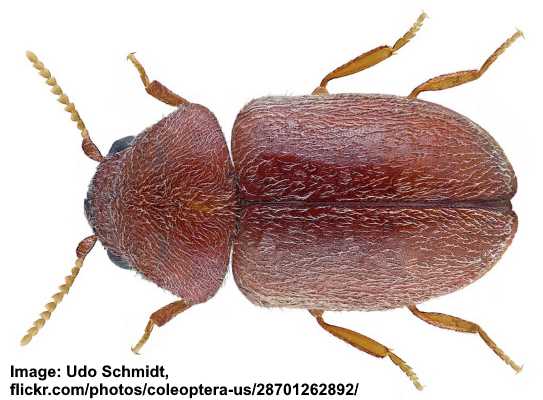
The tiny brown cigarette beetle is attracted to dried tobacco products and dry foodstuffs
House Beetle Identification
The drugstore beetle is identified by its fuzzy brown oval body and short segmented pale yellow antennae.
How to Get Rid of The House Beetles
To get rid of the flying house beetles, removing their food source is vital. This means storing all dried foods in sealable containers and not leaving pet food out overnight.
Click Beetle (Elateridae)
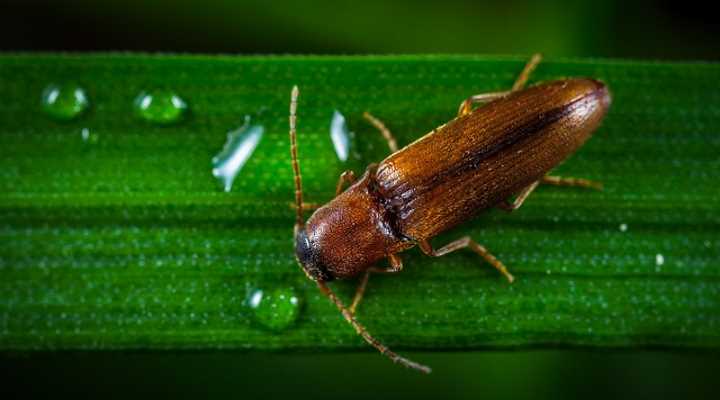
Denticollis linearis (in the picture) is a type of a small brown beetle belonging to the family Elateridae
Click beetles are large flying beetles with an elongated black or brownish body. Click beetles are easy to recognize because of the distinctive clicking noise they make when they feel threatened. The dark brown flying beetles can measure 0.5” to 1” (13 – 25 mm) long.
The nocturnal flying bugs are drawn toward light. Although finding click beetles in the house is relatively rare, they can find their way in through open windows in the evening. Generally, it’s unnecessary to worry about finding a beetle that makes clicking noises in your house.
Related articles:
